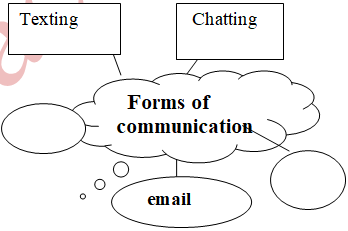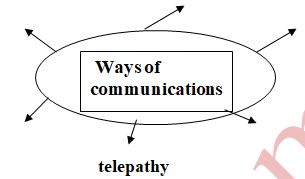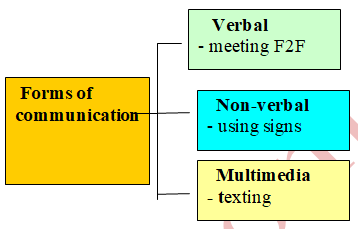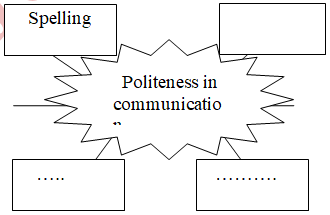Period : 78
UNIT 10 : SOURCES OF ENERGY
Lesson1 :Getting Started
I. Objectives:
- By the end of the lesson, Ss will have some information about communication and they are able totalk aboutthe different types of communication
- Develop Ss’ listening, speaking, reading and writing skills.
- Vocabulary: Types ofCommunication
- Grammar: Future continuous tense and verb- forms
II. Teaching aids.
Textbook ,workbook, a CD & a cassette player
III. Teaching procedures
A. Class organization:
+ Greeting
+ Checking attendance: 8A1:......./.......8A2:......./.......8A3:......./.......
B. New lesson:
|
Sts’ and T’s activities |
Contents |
||
|
1. Warm- up - Have Ss play games related to the topic - Have Ss read the words 3 times in chorus - Ask Ss to describe the picture ( Who, where , what ….. ? ) - Asking some questions - Set the sense - Lead to the new lesson |
A, What types of energy do you know ? B, Where do they come from ? ( renewable & non-renewable ) I. Vocabulary. Communication ways |
||
|
2.Presentation - Elicit some new words from the P and situations , realias - Read many times in chorus -Checking vocab:Slap the board - Call some individuals |
|
||
|
3 Practice -Have Ss do Ex1-a - Guide Ss how to do Ex1 - Call some Ss to give the answer - provide the answers - Then,doEx1-b ( Group-work ) - Ask some groups to present their work before the class - Ask Ss to do Ex2 in chorus - call some individuals - cross – check - Ask Ss to do Ex3 (individually) - cross – check -T provide the keys |
II. Practice . 1.Listen and read . 1.a, Find the words or phrases in the conversation that mean : 1.wait for ages 2.show up 3.get through 4.My battery was flat 5.Are you kidding ? 6.We can try again 1.b, Decide If the sentences True or False . 1- T2, T3, F4, T5, T6, T 1.c, Why ? They couldn’t see the film together because Nick went to the wrong cinema. They didn’t communicate clearly the name and the address of the cinema . Then they are not able to contact each other because the battery of Nick’s mobile phone was flat . 2.Matching . 1.having video conference 2.emailing 3.video chatting 4.meeting face-to-face 5.using social media 6.using telepathy 7.sending letters 3.Fill in the gaps . 1.using social media 2.meet face-to-face 3.emailing ; sending letters 4.using telepathy 5.video chatting 6.having video conference |
||
|
4. Production -Divide the class into 6 groups -Have Ss make up the dialogues then role-play -the groups take turns to present their dialogue -T Listen and feedback |
4.Game :
|
||
|
5. Homework - Learn by heart all the new words. - Prepare for next lesson ( find the meaning of the new words in the next lesson ) - Do B1, B2(workbook) |
* Do homework at home |
………………………………………………………………………………………..
Period : 79
UNIT 10 : SOURCES OF ENERGY
Lesson2 : A Closer Look 1
I. Objectives:
- By the end of the lesson, Ss will be able to talk about types of energy sources, and know how tostress in thethree-syllable words .
- Develop Ss’ listening , speaking and writing skills
- Vocabulary:Advantages & Disadvantages of energy .
-Phonetics :How to tress in the three-syllable words.
II. Teaching aids.
Textbook ,workbook, a CD & a cassette player
III. Teaching procedures
A. Class organization:
-Greetings
-Checking attendance: 8A1:......./.......8A2:......./.......8A3:......./.......
B. New lesson:
|
Sts’ and T’s activities |
Contents |
|||
|
1. Warm- up - Have Ss play game “ spider-web of words ” - Read 3 times in chorus - Lead to the new lesson (old Lessonif necessary) |
I. Vocabulary *verbal and non-verbal communication. |
|||
|
2. Presentation -Elicit some new words ( pictures , realias , situations ….) - Have Ss read many times in chorus - call some individuals - Checking vocab: Hang-man |
Note : Which way do you like best ? Why ? |
|||
|
3.Practice -Have Ss do Ex1 on the text book -Guide how to do -Ask Ss todo in 5 minutes -Provide the keys -Have Ss work in pairs to do ex2 -Cross –check -T feedback -Have Ss do Ex3 on the text book. -Guide how to do -Ask Ss todo -Provide the keys - Ask Ss to write down on the notebooks |
* Practice . 1.Choose the word / phrase and match with the right pictures . 1.using music 2.using signs 3.leaving a note 4.painting a picture 5.communicating non-verbally with animals 6.using codes 7.sending flowers 2.Matching 1, d2, e3, b 4, c5, a 3.Complete the diagrams
4.Which way of communication is better ? Why ? ( Ss’ answers ) |
|||
|
4. Pronunciation. - Guide Ss how to stress the nouns and the adjectives with three syllables - Give examples -explain the rules - Have Ss practice in chorus - Ask Ss to do Ex 4 & 5to distinguish thetwo ways of stressing three-syllable words - Have Ss practice - cross-check - call some individuals |
II. Pronunciation . * How to stressthe words ending in the suffix “ ity& itive ” Rule1 :The stress falls on the syllable that is in front of the suffix itself . Eg :oppor’tunity , ‘ positive ,a’bility , com’petitive * Practice . 5. Mark the stress of the following words . 1.com’petitive 2.in’finitive 3.re’petitive 4.‘positive 5.a’bility 6.possi’bility 7.curi’osity 8.natio’nality 6. Fill in the gaps . 1.natio’nality 2.re’petitive 3.com’petitive 4.possi’bility 5 a’bility |
|||
|
5. Homework -Learn by heart all the new words. - Doexercises of part A inworkbook. -Prepare for next lesson ( find the meaning of the new words in the next lesson ) |
* do at home |
--------------------------------------------------------------------
Period : 80
UNIT 10 : SOURCES OF ENERGY
Lesson 3: A Closer look 2
I. Objectives:
- By the end of the lesson, Ss will be able to talk aboutcommunication
and they master the uses of the future continuous tense andgerund or Infinitives
- Develop Ss’ listening , reading and writing skills.
- Vocabulary:
- Grammar:The future continuous tense and To- Infinitives
II. Teaching aids.
Textbook ,workbook
III. Teaching procedures
A. Class organization:
-Greetings
-Checking attendance: 8A1:......./.......8A2:......./.......8A3:......./.......
B. New lesson:
|
Sts’ and T’s activities |
Contents |
||
|
1. Warm- up - Have Ss answer some questions -Lead to the new lessons |
* Questions : 1.What willhappen to communication in the future ? -We will use telepathy to communicate -We will ............................................... -............................................................ |
||
|
2. Presentation: - Give examples -Explain other uses of - Give the form -Have Ss workin pairs to do Ex 1,2, 3 ( work individually) - Call someone to present their answers. - Cross –correct - Provide the keys - Ask Ss to write down on their notebooks |
* Grammar . I. The future continuous tense . ( review) * Examples : - At 8.00 tomorrow morning, I will be learning Math at school. - This time next summer , we will be visiting Paris => expressing an action in progress at a definite point of time in the future .
Note 1 :The future continuous often company with a definite point of time in the future ( Adverbs of time )such as On Sunday next week , At 8.00 tomorrow morning This time next summer By 2020 ,…………… Note2 : Sometimes we use this tense to predict something in the future . *Practice : 1. Listen again to part of the conversation in GETTING STARTED . Underline the future continuous tense and answer the questions. * Key: 1. He will be having his Vietnamese class 2. They will be watching a film at the cinema. 2. Complete the sentences with the future continuous. * Key: 1. Will he still be sleeping; will be studying 2. will be having 3. will be eating 4. Will she be staying; will be writing 5. will be playing 6. will be learning 3. Work in groups to predict when the following may happen in the future. ( Ss’ answers ) |
||
|
3. Practice - Give the form - Give examples -Explain other uses of the passive voice. - Have Ss workin pairs to do Ex5 ( work individually) -Call someone to present their answers. - Cross –correct - Provide the keys - Ask Ss to write down on their notebooks |
II. Verb + to-infinitive 4. Look at the conversation in GETTING STARTEDagain and write down all the verbs that are followed by to-infinitive. Eg: I also wanted to call you -> want to do something WATCH OUT! +" hate, love, prefer…" can be followed by both a gerund and to-infinitive, but not change their meanings + “try , stop , remember ....” can be followed by both a gerund and to-infinitive, but change their meanings 5. Choose the best answer. Key: 1. c2. b3. a4. c5. a |
||
|
4 . Production - Ask Ss to work in pairs /in groups of four. - ask Ss to make a " Dream List". If it is possible, this task can be done as a mingle activity where one pair has to talk to at least three other pairs.. - Call some pairs / groups to present their answers - Cross -check - T feed-back |
5.The dream list.
|
||
|
5. Homework -Learn by heart all the new words. -Prepare for next lesson ( find the meaning of the new words in the next lesson ) -DoB3,4,5,6 ( workbook) - Redo section 2,6, – students’ book |
_______________________________________________________________
Period : 81
UNIT 10:COMMUNICATION
Lesson 4: Communication
I. Objectives :
- By the end of the lesson, Ss will be able to talk about their communication as well as the ways how to solve the problems in communication. Sswill be active while practising doing exercises .
-Developing Ss’ reading and speaking skills.
- Vocabulary:ways tosolve the problems in communication.
- Skills :reading and speaking skills.
II. Teaching aids.
Textbook ,workbook,
III. Teaching procedures
A. Class organization:
-Greetings
-Checking attendance: 8A1:......./.......8A2:......./.......8A3:......./.......
B. The fifteen-minute test
(Give the fifteen-minute test)
|
Full name:....................................................... Class: 8A..... |
WRITTEN TEST 15’ - N0 04 ENGLISH 8 |
I. Choose the word that has the underlineddifferently from the others
1. a. reader b. heavyc. cleand. mean
2. a. reused b. returnedc. mashedd. cleaned
3. a. those b. clothes c. shopping d. envelope
4. a. down b. throw c. nowadays d. how
5. a. fields b. plants c. trees d. newspapers
II. Choose the option A, B, C or D
6. Every few weeks new satellites_____into orbit.
a. are put b. is put c. are puttedd. is putted
7. I ought to give up smoking.
a. should b. could c. mayd. am going to
8. In 1876, the telephone ______ first introduced by Bell and Watson.
a. was b. isc. has beend. had been
9. ____ you mind finishing the work yourself?
a. Will b. Do c. Can d. Should
10. I am happy_____you passed your exam.
a. thatb. to c. in order tod. so that
11. Let’s play tennis instead of _____ television.
a. watch b. watching c. watches d. to watch
12. Tree leaves____to wrap things.
a. should used b. should be used c. should been used d. should be use
13. Is the rubbish______ every day?
a. collectb. collectingc. collected d. be collected
14. We were delighted_____your letter yesterday.
a. to get b. got c. getting d. get
15. Beer_____for breakfast in England years ago.
a. used be drunk b. used to be drunkc. used to drunk d. used to be drank
16. It’s_____to walk in the road.
a. danger b. dangersc. dangerousd. dangerously
17. Would you mind if I _____ the phone?
a. use b. will use c. am going to use d. used
18. The house _____ on the hill started slipping.
a. build b. buildsc. buildingd. built
19. It was late, so we decided _____ a taxi home.
a. take b. to take c. taking d. took
20. Will you pick me _____ after the party?
a. on b. over c. through d. up
__________________The end__________________
Answer keys and marks
I. Choose the word that has the underlineddifferently from the others
1. b2. c3. c4. b5. b
II. Choose the option A, B, C or D
6. a7. a8. a9. b10. a
11. b12. b13. c14. a15. b
16. c17. d18. d19. b20. d
C. New lesson
New lesson:
|
Teacher’s& Students’ activities |
Contents |
||
|
1.Warm up: - Have Ss play game “Networds ” - Set the sense . - Lead to the new lesson (old Lesson if necessary) 2. Presentation - Elicit some new words from pictures and situations - Read aloud many times in chorus - Checking vocab: matching game - Call some individuals |
I.Vocabulary. * Communication problems.
|
||
|
3.Practice . -Have Ss do a test/ do ex1 ,2 & 3 -Guide how to do ( individually) - Ask Ss to work in groups of six 1 student is the monitor 5 student are the participants - Call some groups to represent their works . - Feedback - Give the answers |
I.Practice 1.Match the following possible reasons fo communication breakdown * Key: 1. A2. B3C 4. C5. A6. B 2. Match the body language with the meanings. * Key: 1. c2. a3. e4. b5. d 3. Using the abbreviations for online chatting and texting is not always easy to understand. * Key: 1. Where are you? We are at Lotte on the second floor. 2. I'll be 5 minutes late. See you soon. 3. Do you want to see a movie this weekend ? 4. Please call me right back. Thanks. 5. Hi! What are you going to do tonight? 6. Did you see it ? Laugh out loud! |
||
|
4. Production - Have Ss work in pairs - Call some Ss/ pairs to represent their report beforethe class - Feedback |
4. Ideas bank. Work in groups Eg: Language barrier : We will use an app on a smart-phone ........... ....................................................................... ( Ss’ own answers ) |
||
|
5. Homework -Learn by heart all the new words. -Doexercises of part C inworkbook. -Prepare for next lesson (find the meaning of the new words in the next lesson) |
Do at home |
_______________________________________________________________
Period :82
UNIT 10:COMMUNICATION
Lesson 5: SKILLS 1
I. Objectives:
- By the end of the lesson, Ss will get some more information about communicationas well aswell be able totalk aboutthem. Sswill be active while practising doing exercises.
- Develop Ss’ reading and speaking skills.
- Vocabulary:communication
- Skills : How to take a survey
II. Teaching aids.
Textbook ,workbook,
III. Teaching procedures
A. Class organization:
-Greetings
-Checking attendance: 8A1:......./.......8A2:......./.......8A3:......./.......
B. New lesson:
|
Sts’ and T’s activities |
Contents |
|||||||||||||||||||||
|
1. Warm- up * Discussion : - Have Ss chat - Set the sense - Lead to the new lesson (old Lesson if necessary ) |
1. Discussion : A, What do you think about the communication in the future ? B, What do you think of real letter ? (SS’ answers ) |
|||||||||||||||||||||
|
2. Pre-task - Elicit some new words ( pictures , realias , situations ….) - Have Ss read many times in chorus - Call some individuals * Checking vocab: Slap the board and remember |
I. Vocabulary : exchange (v): trao đổi interact (v): tương tác holography (n): phép ghi ảnh toàn kí device (n): thiết bị cyber world (v): thế giớ ảo NOTE : It is said that ................................ (người ta nói rằng………) |
|||||||||||||||||||||
|
3. Practice - Guide Ssthe way how to do Ex2 - Ask Ss to workindividually - Call some Ss to the black-board - Provide the correct answers - Guide Ssthe way how to do Ex3 - Ask Ss to practicein pairs - Cross –check - Call some Ss to the black-board - Provide the correct answers - Ask Ss to write down on their notebooks |
II. Practice . A. Reading . 2. Matching. 1.in real time 2.interact 3.three-dimensional images 4.cyber world 5.network 3. Read the text then answer the questions . 1.They love to write and read the real letters 2.They are telepathy and holography ......................................................... 3.She prefers to use real , face to face communication because she thinks this makes life interesting |
|||||||||||||||||||||
|
- Have Ss workin groups -Call some to role-play before the class - Cross-check -T feedback |
B. Speaking : 4.Decide whether you agree with the author ? Why? Why not ? ……………………………….. ……………………………………… |
|||||||||||||||||||||
|
4 . Production - Divide the class into 4 groups - Have Ss make a speech about the advantages and disadvantages of each type of energy source . - T observe - call some groups to represent their work - Feedback |
5.Class survey
|
|||||||||||||||||||||
|
5. Homework - Learn by heart all the new words. -Doexercises of part D inworkbook. -Prepare for next lesson ( find the meaning of the new words in the next lesson ) |
Do at home |
Period:83
UNIT 10:COMMUNICATION
Lesson 6 :SKILLS 2
I. Objectives:
- By the end of the lesson, Ss will be able to write a passage aboutcommunication and the ways how to use the politeness in communication. Sswill be active while practising doing exercises.
- Develop Ss’ listening and writing skills
- Vocabulary:politeness in communication.
- Skills :How to write an email .
II. Teaching aids.
Textbook ,workbook, a CD & a cassette player
III. Teaching procedures
A. Class organization:
-Greetings
-Checking attendance: 8A1:......./.......8A2:......./.......8A3:......./.......
B. New lesson:
|
Sts’ and T’s activities |
Contents |
||||||||||||||||||||||||||
|
1.Warm- up - Have Ss play game “ spider-web of phrases” - Read 3 times in chorus - Set the sense - Lead to the new lesson (old Lesson if possible) |
* Discussion .
|
||||||||||||||||||||||||||
|
2.Presentation - Elicit some new words ( pictures , realias , situations ….) - Have Ss read many times in chorus - Call some individuals * Checking vocab: What & Where |
I . Vocabulary: * Netiquette in communication . Netiquette : the rules of correct or polite behaviour among people using the Internet ( phép lịch sự trong giao tiếp qua mạng) e-learning message board : diễn đàn học tập trực tuyến CAPS LOCK: a function that turns all letters into capital form. |
||||||||||||||||||||||||||
|
3.Practice - Have Ss guess the answers before listening - Cross-check - Play the tapes - Call someone to give their answers - Play the tape again - provide the keys - Ask Ss to work individually - Cross –check - Call some Ss to the black-board - Provide the correct answers - Ask Ss to write down the answers on their notebooks |
II. Practice. A.Listening . 1. Discussion . Ex 1. It use capital letters, "WHEN IS THE FIRST ASSIGMENT DUE??!!!!!!!!!!". Writing in all capital letters is considered yelling online. It show the communication impoliteness. 2. Listen and answer the questions . 1. The word is a combination of "net" and "etiquette". It's a set of rules for behaving properly online. 2. Don't say and do unpleasant things online, just like real life. 3. We should pay attention to how to write message or comments, for example use polife language, don't use too much shorthand, don't use CAPS LOCK and check email for mistakes or errors. 3.Listen again and complete the grid .
4. Add more to the netiquette you have learnt so far Dear teacher, Please let me know when the first assignment is due? Thank you. Best regards, Writing. 5. Put the parts into the correct order to make an e-mail .
|
||||||||||||||||||||||||||
|
4 . Production - Divide the class into 6 groups - Have Ss practiceingroup - Present their works on the sub-boards - T observe - Feedback |
6. Write a short e-mail to your teacher to submit your group homework for this week . To: hoangnam@gmail.com Subject: Group homework this week Attachment: vietjack.docx Dear teacher, My name is Huynh Thao Linh. I am a student in class 8A. I am a representative of group 1 including 5 students. Please find attached our group homework for this week. Thank you very much. Yours respectfully |
||||||||||||||||||||||||||
|
5. Homework -Learn by heart all the new words. -Doexercises of part E inworkbook. -Prepare for next lesson (find the meaning of the new words in the next lesson ) |
Do at home |
Period:84
UNIT 10:COMMUNICATION
Lesson 7 : Looking back & Project
I. Objectives:
- By the end of the lesson, Ss will be able to review about communication and the ways how to use the politeness in communication. Ss must have good attitude while doing the tasks together .
- Develop Ss’ reading, speaking and writing skills
- Vocabulary:politeness in communication.
- Grammar:The future continuous tense and To- Infinitives/gerund
II. Teaching aids.
Textbook ,workbook
III. Teaching procedures
A. Class organization:
-Greetings
-Checking attendance: 8A1:......./.......8A2:......./.......8A3:......./.......
B. New lesson:
|
Teacher’s and Ss’activities |
Contents |
|
1.Warm – up. LOOKING BACK Encourage Ss not to refer back to the unit. Ask them to keep a record of their answers to each exercise so that thay can use that information to complete the self – assessment box at the unit. 2.Vocabulary 1. Complete the sentences using the cues provided. Ask Ss to complete the sentences by using the support from the picture, the letter cues, and the meaning of the sentences. 2. Write the following text messages/ chat lines in shorthand form. Challenge Ss to try this task without looking back at COMMUNICATION. Have two or three Ss write their answers on the board 3. Have you ever used music, art, codes, signs or any non – verbal ways to communicate? Tell a partner what you did. Was the communication successful? Ss work in pairs for this task. Remind Ss that these are non – verbal ways of communication. Then call on some pairs to report their talk. 3.Grammar 4. Underline the correct answer. 5. Gerund or to - infinitive? If time allows encourage Ss to think of other verbs that are followed by gerunds and by to - infinitives and make sentences using them. 4. Communication 6 Choose any three forms of communication in this unit and work with a partner to decide if people will be using them in the year 2100 or not. Give at least two reasons for each decision. PROJECT Remind Ss of: - The reasons for communication breakdown in COMMUNICATION - different ways of communicating in GETTING STARTED and A CLOSER LOOK 1 Put them into groups and ask them to think of a sketch or a role – play of a communication breakdown. 5.Homework Preparefor unit 11 lesson 1 |
Chatting Key: 1. body language2. Multimedia 3. Face - to - face4. cultural differences 5. Telepathy6. Netiquette Key: 1. Thx 4 ur gift 2. BTW, wot r u doin this wkd? 3. Pls call me rite now4. LOL! 5. C U 2nite. Key: 1. will not be sleeping 2. Will be playing 3. Will he be doing 4. will be waiting 5 will not be using; will be using6. Will be raining Key: 1. talking2. To use 3. To show4. communicating 5. Chatting6. To have Key: (NB. Encourage each group to try to find their own reasons and provide these keys only if they ask for help.) |






